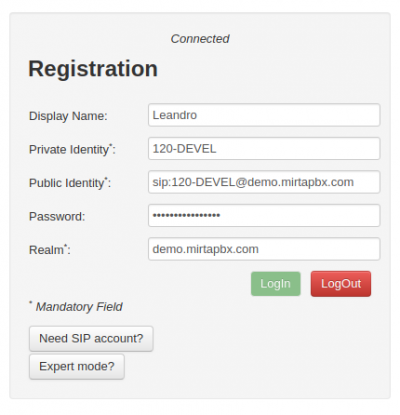Enabling WebRTC: Difference between revisions
Jump to navigation
Jump to search
No edit summary |
No edit summary |
||
| Line 32: | Line 32: | ||
[[File:sipML5.png|400px]] | [[File:sipML5.png|400px]] | ||
Revision as of 13:50, 4 February 2018
WebRTC is not enabled by default and you need to follow carefully the following steps to make it work.
- Install an SSL certificate on Asterisk. This needs to be a real SSL certificate. Check the Asterisk FAQ on how to install an SSL Certificate in Asterisk
- Install the Opus codec and add to the web interface. You can check the instructions in the Setup Guides section Installing OPUS codec
- Activate the http daemon for asterisk by editing the http.conf file as following:
[general] enabled=yes bindaddr=0.0.0.0 bindport=8088 tlsenable=yes tlsbindaddr=0.0.0.0:8089 tlscertfile=/etc/asterisk/certificates/demo.mirtapbx.com.pem
The tlscertfile needs to point to your certificate in pem format
- Activate the ws and wss transport in sip.conf, set the realm
transport=udp,tls,ws,wss realm=demo.mirtapbx.com
- Set the path for your certificate in the Web interface - Admin/Settings, Security section, WebRTC SSL path field
- In your extension enable Opus Codec, RTP Encryption and Any Transport
Verifying WebRTC
To verify the WebRTC configuration, you can try to register and place calls using the SipML5 by visiting: https://www.doubango.org/sipml5/
